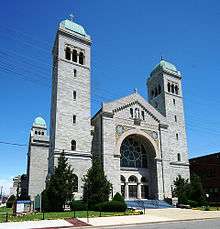St. Mary Star of the Sea Catholic Church (Jackson, Michigan)
| St. Mary Star of the Sea | |
|---|---|
 | |
| Basic information | |
| Location |
120 E. Wesley St. Jackson, MI |
| Geographic coordinates | 42°14′42″N 84°24′19″W / 42.2451°N 84.4054°WCoordinates: 42°14′42″N 84°24′19″W / 42.2451°N 84.4054°W |
| Affiliation | Roman Catholic |
| District | Diocese of Lansing |
| Year consecrated | 1926 |
| Leadership |
Rev. Timothy Nelson Rev. Richard Eberle, OSFS |
| Website | Parish website |
| Architectural description | |
| Architect(s) | Frederick Spier |
| Architectural type | Church |
| Architectural style | Byzantine Revival, Romanesque Revival |
| Groundbreaking | 1923 |
| Completed | 1926 |
| Construction cost | $375,000 |
| Specifications | |
| Height (max) | 180 feet |
| Materials |
Limestone Steel Copper towers |
St. Mary Star of the Sea is a Catholic parish church located in downtown Jackson, Michigan. The parish was the second in the Jackson area, after St. John the Evangelist.
History
In 1880, Bishop Caspar Henry Borgess of the Detroit Diocese approved the establishment of a second Catholic parish in the city of Jackson.
On June 14, 1881, Robert Lake was contracted to build a new church. It was to be Gothic style and of brick with the steeple rising 180 feet. The cornerstone was laid July 4, 1881. It would seat six hundred people and the cost was just over $30,000. Within 20 years, this first church had become inadequate in size, and admission cards were issued to parishioners for mass.
In 1910, plans were announced for the current church, and the pastor and church trustees traveled to Europe, viewing some of the most beautiful cathedrals. Building plans were delayed by World War I, but finally on Sunday, September 23, 1923, the cornerstone was laid. The basement was ready and used for Midnight Mass on Christmas, 1923. However, a prolonged strike in the limestone industry delayed progress and it was not completed until 1926. On May 31, 1926, Bishop Joseph C. Plagens officiated at the dedication. The cost of the new church was approximately $375,000.
In the fall of 2008, St. Mary Parish merged with St. Stanislaus Kostka Chapel in Jackson, which houses both the Polish community of the former St. Stanislaus Kostka Parish and the Mexican community of Sacred Heart, formerly an independent chapel at a separate site in Jackson.
Architecture
Exterior
Frederick Spier of Detroit designed the Romanesque Revival structure. It is constructed of steel framework with an exterior limestone veneer, and is a combination of Byzantine and traditional Romanesque architecture. The front of the church originally featured two lighthouses where wrought iron lamps now stand.
The steeple rises 180 feet. The southwest corner houses the 2,700 pound bell, cast in 1902 for the parish's original church. All three towers are capped with copper sheeting, which is curved to meet at the top with a wood post that supports a 6' x 3' x 6' gold-leafed metal clad cross.
The front features three sets of double doors of copper and bronze. Over the entrance is a figure of Mary and the words "Domus Mea Domus Orationis Est" which translated from the Latin is "My House is a House of Prayer" taken from Isaiah 56:7.
Interior
Statues of Mary, Joseph, St. Anne with Mary, Divine Mercy, St. Therese, St. Roch, Pius X, the communion rail, and back altar are all made of Italian Carrara marble. The altars and communion rails were a donation by George Washington Hill, the president of the American Tobacco Company. The red and green colors of the mosaic work on the main altar correspond to the original colors on a pack of Lucky Strike cigarettes.
All of the stained glass windows, stations of the cross, and mosaic "Our Lady Star of the Sea" were purchased after World War I from Tyrolese Art Glass Company in Innsbruck, Austria for $22,000. In 1961, the windows were appraised for $150,000. The Stations of the Cross were appraised at $16,000 at that time.
A notable stained glass window is entitled "Christ and the Battlefield."[1] The window was created from a design made by the church pastor, Eugene M. Cullinane. It is a World War I memorial to "all Jacksonians serving in the Armed Forces and to the nuns and nurses who cared for them on the battlefields." At the right of the scene are soldiers and sailors arriving on shore, bearing the American flag and supporting the wounded. To the left are other soldiers and a Sister of Charity of St. Vincent de Paul tending a fallen nurse. Behind them St. Mary looks upward toward figures of Christ and attending angels
School
A school associated with the church, St. Mary's, was built in 1889. When the school opened that October as a high school, it was staffed primarily by the Sisters of Charity from Cincinnati, Ohio. It was accredited in 1915 by the University of Michigan.
In 1950 the school purchased an adjacent building to add space to provide primary education. In 1956 more classrooms were added to the main school building and another building was purchased in 1959. The last class to graduate from St. Mary's High School did so in 1968, when Lumen Christi Catholic High School opened in Jackson and St. Mary's stopped offering secondary education. St. Mary continued to educate students through eighth grade until the opening of Jackson Catholic Middle School in 1971. During the 1980s and 1990s the enrollment fluctuated as parents were faced with more choices and the neighborhood changed. In 1999, St. Mary's and St. Stanislaus Kostka's schools merged, with students from St. Stanislaus Kostka enrolling in St. Mary's school.
The school provides pre-kindgarten through sixth grade secular and K-12 religious education. A licensed daycare center was established in 1990.
References
- ↑ "Christ and the Battlefield". Michigan Stained Glass Census. Retrieved 16 August 2013.
